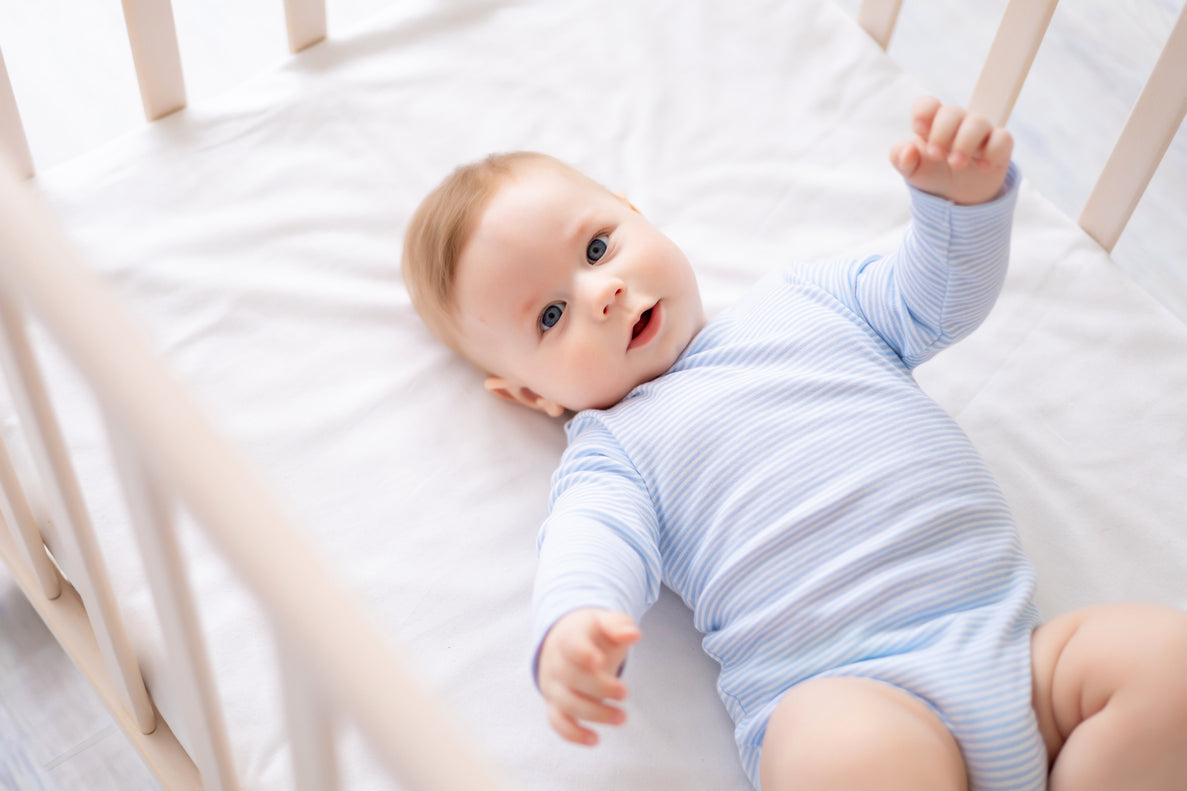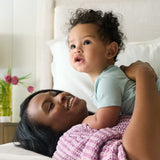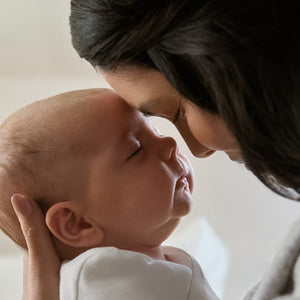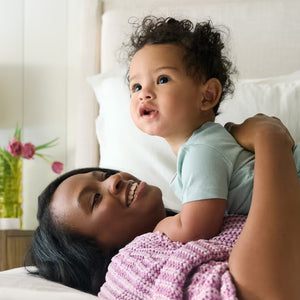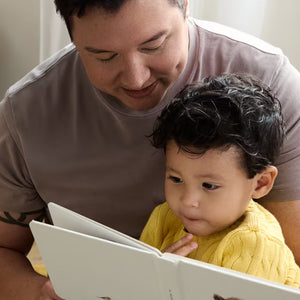Are you wondering when to move your baby from the bassinet to the crib? I know families have questions about the bassinet to crib transition. Let’s talk about the benefits of each, when to move from the bassinet to a crib, and how to transition your baby to a crib.
Can a newborn sleep in a crib? Does my newborn need a bassinet?
A newborn can safely sleep in a crib or a bassinet. Newborns don’t need a bassinet for sleep, but many families find them convenient. Let’s compare a crib vs. a bassinet.

Text version of Crib vs Bassinet
| Crib | Bassinet |
|---|---|
| Large and not easily movable | Easily movable from room to room |
| Larger sleeping space | Smaller sleeping space |
| Safe option when safe sleep guidelines are followed | Safe option when safe sleep guidelines are followed |
| Can be used from birth until 2.5-3 years old | Can be used from birth until 4-6 months old |
Whether your newborn is sleeping in a crib or a bassinet, it’s important to follow safe sleep guidelines.
Important Note: Keep in mind that a safe crib or bassinet:
Uses a firm mattress designed for infant sleep
Provides a flat surface for sleep (not at an angle, even for babies with reflux)
Is free of anything other than a tightly fitted sheet or a pacifier
Is labeled as a crib, bassinet, portable crib, or play yard (No loungers, sleepers, nappers, or surfaces by any other name are approved for safe sleep)
How long can babies sleep in a bassinet?
Bassinets can work perfectly for the first several months. It’s time to transition to a crib when your baby can sit independently, push up on their hands and knees, or they outgrow the manufacturer’s height/weight recommendations on your bassinet (whichever comes first). There’s no exact age that a baby needs to transition to the crib, but those safety guidelines mean that most babies should transition to a crib by 4-6 months. This ensures you are providing the safest sleep environment for your little one.
When can a baby sleep in their own room?
There is no universal answer to this question. This decision is a personal one for every family. Some families choose to have their baby start out in their own room, while others choose to wait until their baby is older. I encourage room sharing for the first few months of your baby’s life and even longer if that’s best for your family.
The American Academy of Pediatrics (AAP)(1) recommends that your baby sleeps in your room for at least the first 6 months of life. However, there is also research(2) from the American Academy of Pediatrics demonstrating that after 4 months, room sharing results in less sleep and an increase in unsafe sleep practices. For more on this, let me walk you through all of the research on room sharing.
Expert Tip: If your baby sleeps in your room at night, you can still offer naps in their crib and nursery during the day! This a great opportunity for your baby to practice crib naps.
All of my classes are designed to help you have a great little sleeper whether your baby is room sharing or in their own room.
When do I move my baby to a crib?
There are a few reasons to make the bassinet to crib transition:
-
Your baby is beginning to sit independently. If your little one is able to stay in a seated position without assistance (or is about to master this skill) then it’s time to make the move from a bassinet to a crib.
-
Your baby is beginning to push up on their hands and knees. If your little one is able to get into a crawling position then it’s time to transition to a crib.
-
Your baby has met the height or weight maximum for their bassinet. The manufacturer of your bassinet will have a height and weight limit. Once your baby meets one of these limits, it’s time to transition out of the bassinet.
-
You feel ready. If you are ready for your little one to sleep in their own room, this is a good time to make the transition out of the bassinet.
Expert Tip: If your baby has outgrown their bassinet but you want to continue room sharing, a Pack ’n Play or portable crib can be a great option.
Can my baby sleep in a bassinet if they are rolling over?
No. Once your baby shows signs of rolling, they should be transitioned to a "crib," "portable crib," or play yard to ensure they have a safe sleeping space.
Safety Tip: Once your little one shows signs of rolling, it’s also time to transition out of the swaddle.
How do I transition my baby to a crib?
If you have decided it’s time to make the transition from the bassinet to the crib, here are my best tips for a smooth transition:
1. Practice sleep in the crib. Allow your baby to nap in the crib 1-2 times per day. You can start this in the first few weeks or as soon as you're ready. That ongoing practice in the crib creates familiarity and comfort with the crib.
2. Follow the same routine. Continuing your consistent bedtime routine will give your baby a familiar cue that it's time to sleep. You'll simply do it in the nursery and lay your baby down in the crib instead of the bassinet.
3. Recreate the same room environment. A similar environment – a firm, flat mattress in a cool, dark room with the humming of a sound machine– will ease the transition between a bassinet and a crib.
4. Plan for a few days of adjustment. Know that it may take your baby a day or two to become comfortable with a slightly different sleep surface. Don’t let that worry you.
If sleep is a mess no matter where your baby is sleeping, my classes can help. My Newborn Sleep Bundle will help you set your days and nights up for success, learn your baby's cues, calm a fussy baby, and so much more. I want to help you lay a healthy sleep foundation for your baby and love the newborn stage.
If your baby is 5 months or older, The 5–24 Month Collection will teach you a holistic, customizable, and emotionally-connected plan. I’ll give you the tools you need to achieve 10-12 hour consolidated nights, make the crib transition, establish solid naps, and conquer all the bumps along the way. It’s the perfect time for you to have a great little sleeper!

